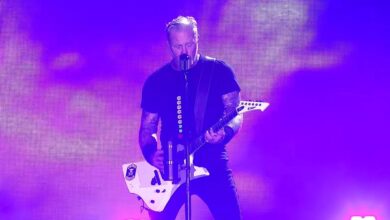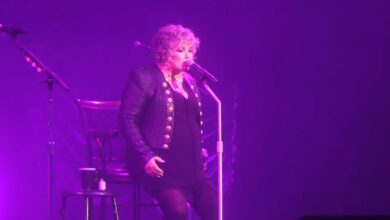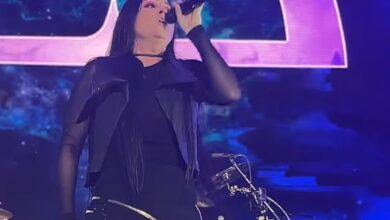Prince’s Super Bowl Halftime Show: The Night He Asked the Sky to Rain Harder
When Prince took the stage at Dolphin Stadium on February 4, 2007, he faced the biggest show in American entertainment—and a sky that refused to cooperate. The first Super Bowl ever to be played under steady rain turned the field into a mirror of water and light. Before the game even began, word spread of a legendary exchange backstage: when told about the worsening weather, Prince simply smiled and asked, “Can you make it rain harder?” It was the kind of fearless response only a true showman could give, turning what others feared into fuel for the moment that would define him.
The Super Bowl that night featured the Indianapolis Colts and Chicago Bears, but when halftime arrived, all eyes turned to a different contest—Prince against the storm. More than 74,000 fans in ponchos filled the stadium as crews rolled out a glowing purple stage cut in the shape of his iconic “love symbol.” The slick platform, dangerous in the rain, shimmered like glass under the floodlights. For most performers, it would have been a nightmare. For Prince, it was an invitation to defy gravity and expectations all at once.
Behind the spectacle, an entire army of workers executed one of the most complex halftime builds ever attempted. Seventeen interlocking stage pieces were pushed into place by volunteers, forming the gleaming platform in minutes between plays. Cameras rolled as rain poured down, and producers held their breath. It was live television with no margin for error—an unpredictable storm and a perfectionist performer who demanded everything unfold exactly right. And somehow, it did.
Then, with lightning flickering in the distance, Prince rose from beneath the stage. Dressed in turquoise and orange, he looked like a burst of color against the gray sky. Without hesitation, he launched into “Let’s Go Crazy,” his guitar snarling and echoing off the wet turf. The crowd roared back, instantly caught in the electricity of the moment. Every move he made defied the rain; every riff he played turned the storm into rhythm. What was supposed to be a risk became revelation.
He followed with a medley that included “Baby I’m a Star” and “1999,” joined by the Florida A&M University Marching 100. Their brass lines cut through the rain like thunder, transforming the soaked field into a celebration of sound and color. The camera swept across musicians and dancers shining under floodlights, every note amplified by the weather. Rather than drown the performance, the rain became part of its choreography—a collaborator instead of an obstacle.
Then came a shift no one saw coming. Prince dove into Creedence Clearwater Revival’s “Proud Mary” and seamlessly transitioned into Bob Dylan’s “All Along the Watchtower.” The pairing was unexpected yet masterful, his guitar bridging decades of American music in a single stretch. Each song was transformed in his hands, reshaped with funk, fire, and emotional command. It wasn’t a cover medley—it was a conversation between musical eras, told through one of the greatest live interpreters to ever hold a guitar.
And then came the night’s boldest move: a cover of Foo Fighters’ “Best of You.” On paper, it was an unlikely choice—a post-grunge anthem meeting a funk icon. But in Prince’s world, boundaries didn’t exist. He turned the track into a gospel-charged plea, wringing every lyric for raw emotion. The line “Is someone getting the best, the best, the best of you” echoed through the stadium like a sermon. It was fearless, unexpected, and utterly unforgettable.
By now, the storm had become a visual effect of its own. Raindrops shimmered under the spotlights, and the stage reflected each flash of light like a pool of liquid glass. Prince’s dancers, The Twinz, punctuated every beat with precision, while he strutted across the soaked surface as though physics no longer applied. The weather had stopped being background—it was part of the story, framing every shot in something unrepeatable. In that moment, danger looked like destiny.
Backstage, producers faced chaos. The combination of water, cables, and live electricity was enough to make any director panic. Inside the broadcast truck, they monitored camera lenses fogging, lights flickering, and audio feeds hissing. Yet through it all, the show remained flawless. What millions at home experienced as effortless magic was in reality a high-wire act balanced on timing, trust, and Prince’s unshakable control of the storm he had asked for.
And then came the moment that sealed it in history. A translucent screen lifted behind him, casting his silhouette in giant scale as the first chords of “Purple Rain” rang out. The rain fell harder, illuminated by a flood of violet light. Prince stood at the center, guitar raised to the heavens, as if summoning the storm itself. The song’s title suddenly felt literal—purple light, falling rain, and music fused into something eternal. For twelve minutes, time seemed to stop.
Inside the control room, technicians maneuvered cameras through mist and water spray, trying to capture shots before droplets smeared the lenses. Every frame felt cinematic, every lightning flash perfectly timed. Against all odds, the broadcast looked pristine. The crew and performer had somehow turned nature’s unpredictability into visual poetry. The weather was no longer the enemy—it had become the muse.
In context, it was revolutionary. After years of “safe” halftime acts chosen to avoid controversy, Prince’s storm-soaked show redefined what live television could be. He mixed Queen, Dylan, Creedence, and Foo Fighters into a single musical statement, proving that legacy and rebellion could coexist. The NFL wanted predictability; what they got was transcendence. Prince didn’t just play a set—he redrew the boundaries of spectacle.
Viewership surpassed 90 million, with critics calling it one of the greatest performances ever televised. Even decades later, it remains the benchmark by which every halftime show is judged. No drones, lasers, or digital tricks have managed to eclipse the sight of a man in a turquoise suit commanding thunder and rain like part of his band. The spectacle wasn’t technology—it was truth performed live, under open skies.
Each rewatch carries the same power. The lightning, the silhouette, the audience drenched yet unblinking—it all feels new every time. The performance lives beyond nostalgia because it wasn’t staged perfection. It was vulnerability turned into art, chaos turned into communion. When Prince asked if it could rain harder, he wasn’t tempting fate—he was inviting it to share the stage. That’s why the world still remembers that night: not as a halftime show, but as a moment when music, weather, and faith collided to create something that will never happen again.
@80sdeennice Prince sings “Purple Rain” (in the rain) in the greatest Super Bowl halftime show of all time 💜 ☔️ When the producers approached Prince before the set to warn him about the rain, he responded, “Can you make it rain harder?” #GOAT #SuperBowlXLI #2007 #prince #80sicon #80s #genx #80smusic #ilovethe80s #80skid #halftimeshow #purplerain #foryoupage ♬ original sound – 80s Deennice





